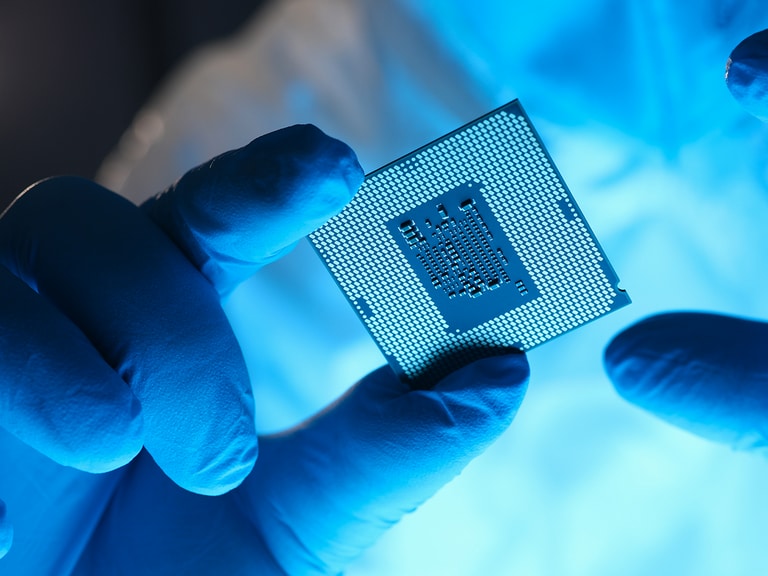Arm’s fourth-quarter earnings painted an upbeat picture at face value, with earnings and revenue beating both analyst expectations and its own prior guidance. However, in an echo of other semiconductor earnings the previous week, Arm’s share price fell after-hours thanks to underwhelming forward guidance.
- Arm reports revenue of $928m and EPS of $0.36.
- Super Micro and AMD share prices fell 16% and 10%, respectively, following their results.
- iShares Semiconductor ETF gained 64% in past 12 months.
Arm Beats, But Falls on Guidance
Two weeks of semiconductor earnings reports have established a recurring pattern.
Despite meeting market expectations on quarterly earnings and revenues, often with substantial year-over-year growth, share prices have typically been dented by underwhelming forward guidance.
After markets closed on 8 May, UK-based chip designer Arm [ARM] announced revenue of $928m, up 47% year-over-year and 6% above the consensus estimate of analysts polled by LSEG, for the quarter ending 31 March. It was also 3.1% above the top end of the revenue guidance range that Arm had issued for the quarter.
Non-GAAP fully diluted earnings per share (EPS) came in at $0.36, having stood at $0.00 a year ago (image shows Arm Holdings CEO Rene Haas ringing the Nasdaq opening bell, 14 September, 2023). This beat analyst expectations by 16.1%, and the top end of Arm’s own guidance by 12.5%.
Notwithstanding this solid performance, Arm’s share price fell nearly 9% in afterhours trading.
One possible reason for this drop was the fact that Arm forecast revenues of $3.8–4.1bn for the 2025 financial year (ending March 2025), which was an underwhelming projection compared to the $4.01bn analysts had expected.
Super Micro and AMD Results
Arm’s earnings came a week after Super Micro Computer [SMCI] and Advanced Micro Devices [AMD] reported their earnings.
Super Micro’s net sales reached $3.85bn, more than tripling from the year-ago quarter, while EPS increased more than fourfold to $6.65. While net sales fell slightly short of the consensus estimates of analysts polled by LSEG ($3.95bn), EPS beat expectations by 15.1%.
AMD’s revenue increased 2% year-over-year to $5.5bn, beating analyst estimates by 0.2%, while EPS increased from $0.60 to $0.62 — 1.6% ahead of analyst consensus.
Despite broadly meeting or exceeding earnings and revenue expectations, both companies’ share prices dropped following the announcements (both on 30 April). Super Micro fell 16% and AMD fell 10% in afterhours trading that day, reported Reuters.
Ironically, chipmakers like these, especially Super Micro, might be suffering from their own past success. “A few quarters ago, Super Micro beat and raised a couple of quarters in a row,” Hans Mosesmann, Senior Research Analyst at Rosenblatt Securities, told OPTO. Investors, he says, are now asking “why didn’t they do it this time?”
While Super Micro increased its full-year revenue guidance to $14.7–15.1bn, this was just 2.75% up from the previous quarter at the midpoint, when guidance was raised 38.1% from $10–11bn to $14.3–14.7bn.
AMD’s revenue guidance of $5.7bn for the next quarter would represent 5.5% year-over-year gains, which is also modest compared to the rapid sales growth that investors have come to expect from chipmakers.
The AI Effect
“There are big expectations associated with companies that have an angle on AI,” said Mosesmann. Their valuations are predicated on assumptions of outsized future growth. Any indication that big tech spending on AI might flag risks denting this confidence, with ominous implications for semiconductor firms’ share prices.
However, there is no doubt that AI continues to be a powerful driver for companies providing its infrastructure.
“AI is driving increased demand for Arm-based technology across all end markets," Rene Haas, CEO of Arm, said in the company’s shareholder letter accompanying the earnings release. “From cloud to edge, all AI software models, from GPT to Llama, rely and run on the Arm compute platform.”
In this light, investors will look ahead to Nvidia’s [NVDA] earnings on 22 May. The AI GPU giant’s share price has gained 216.5% over the past 12 months, lifted by the same balloon of hype that Arm, Super Micro and AMD’s earnings took a pin to.
Nvidia’s share price closed down 3.9% the day after AMD and Super Micro’s earnings and edged downwards following Arm’s report. Market jitters over semiconductor outlook add pressure on Nvidia to demonstrate that demand for its products will remain robust, regardless of its competitors’ forecasts.
How to Invest in Semiconductor Stocks
Arm’s share price closed 8 May up 41.2% year-to-date, and 66.8% up over the last 12 months. AMD’s share price has gained 4.2% year-to-date and 61.6% over the past 12 months.
Nvidia, having made headlines for its astronomical market gains, is leading both with gains of 82.6% year-to-date and 216.5% over the past 12 months. However, even it trails Super Micro, which gained 189.4% year-to-date and 522% in the past 12 months, underscoring the power of the beat and raise cadence that Mosesmann identified.
The semiconductor industry is highly competitive. Each major player is actively seeking to encroach on the market share of competitors by developing the technology that will power the next wave of AI.
There is also competition from big tech players — ostensibly the customers of chipmakers — developing their own AI chips to reduce their reliance on semiconductor suppliers. Mosesmann explains that custom ASICs (developed by companies such as Alphabet [GOOGL]) often outperform third-party chips at specialised tasks.
For that reason, diversification can be a rewarding strategy, as it avoids the risks involved in betting on a single provider’s long-term success.
Few semiconductor ETFs hold all four stocks — most, such as the iShares Semiconductor ETF [SOXX], focus on large-cap stocks and, therefore, omit Super Micro and Arm. For exposure to all four stocks as well as others that are central to the emergence of AI, including their big tech client-competitors, investors can select the Roundhill Generative AI and Technology ETF [CHAT].
Over the past 12 months, CHAT gained 32.8% while SOXX gained 63.9%. In the year to date, the two ETFs have gained 14.1% and 18.26% respectively.
Disclaimer Past performance is not a reliable indicator of future results.
CMC Markets is an execution-only service provider. The material (whether or not it states any opinions) is for general information purposes only, and does not take into account your personal circumstances or objectives. Nothing in this material is (or should be considered to be) financial, investment or other advice on which reliance should be placed. No opinion given in the material constitutes a recommendation by CMC Markets or the author that any particular investment, security, transaction or investment strategy is suitable for any specific person.
The material has not been prepared in accordance with legal requirements designed to promote the independence of investment research. Although we are not specifically prevented from dealing before providing this material, we do not seek to take advantage of the material prior to its dissemination.
CMC Markets does not endorse or offer opinion on the trading strategies used by the author. Their trading strategies do not guarantee any return and CMC Markets shall not be held responsible for any loss that you may incur, either directly or indirectly, arising from any investment based on any information contained herein.
*Tax treatment depends on individual circumstances and can change or may differ in a jurisdiction other than the UK.
Continue reading for FREE
- Includes free newsletter updates, unsubscribe anytime. Privacy policy






